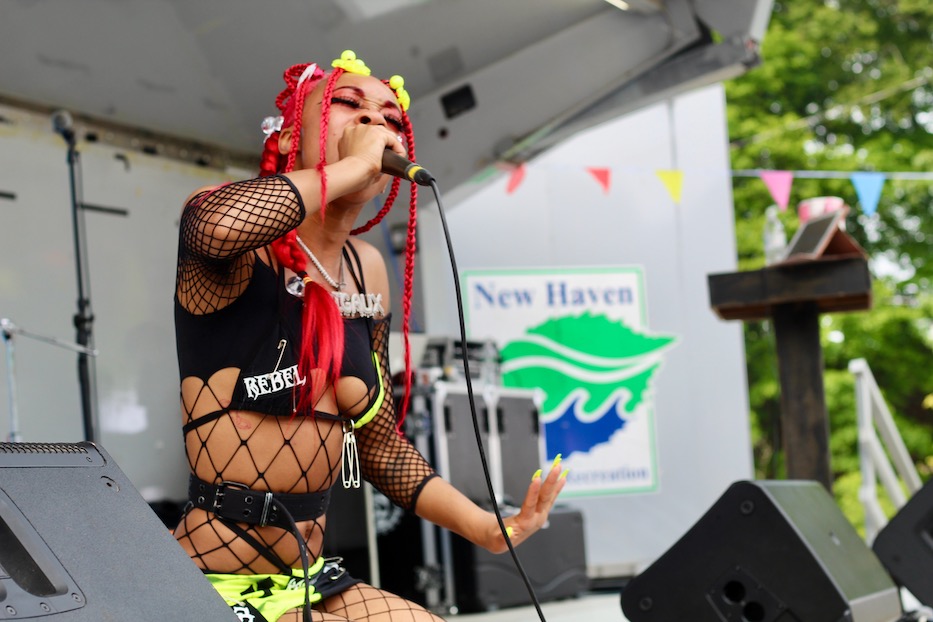
Culture & Community | Music | Arts & Culture | Westville | Edgewood Park | Arts & Anti-racism | Neighborhood Cultural Vitality Grant Program
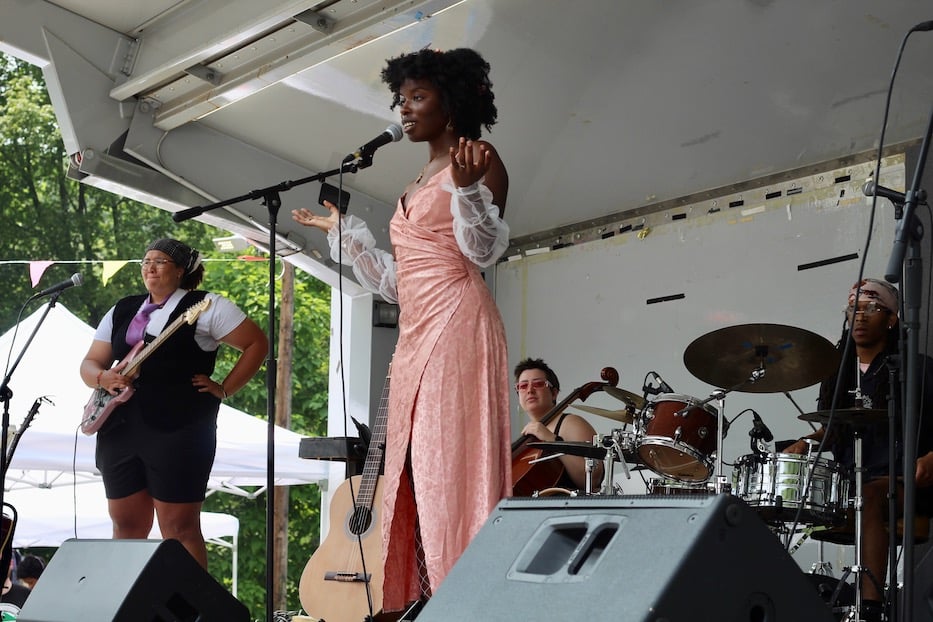
Nehway and band members performing a little past 2 p.m. on Saturday. The festival in full ran for over eight hours, with over a dozen musical acts. Lucy Gellman Photos.
Nehway set her guitar down on the stage, and raised both arms, palms upturned. In front of her, two dozen people swayed at the hips and shoulders, enveloped in a sticky, rising summer heat that no one seemed to mind. A few held hands; others looked out over a sprawl of concrete covered in artist tents, skate shops, and pop-up thrift outlets. Further back, strains of sound drifted in from a second stage, merging with the whoosh of skateboards.
"I just want to be all right/all right/ all right all right," Nehway called out to the audience, and attendees came in close to the stage, drawn in by the sound "Let me hear you! I think I'm gonna be all right/all right/all right all right."
That mood set the tone for the second annual Seeing Sounds Festival, held last Saturday afternoon and evening in Edgewood Park. Organized by singer/songwriter and musician Trey Moore, the festival has become a week-long celebration of Black artists and artists of color—including those who don't always get a citywide platform to perform.
This year, the event included an open mic night, indie film festival at Lyric Hall, and concerts at Stella Blues and in Temple Plaza before Saturday's sun-soaked festivities.
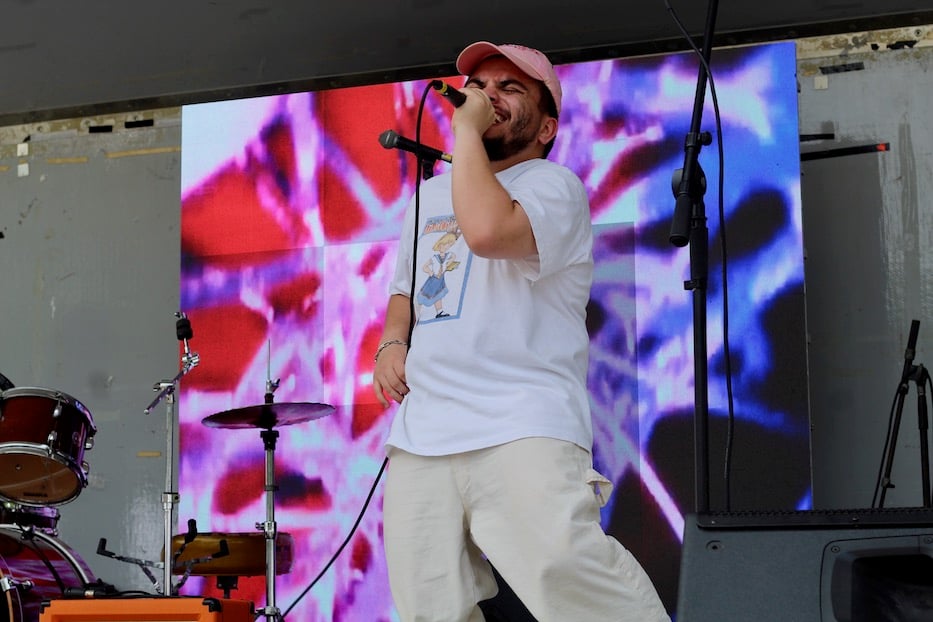
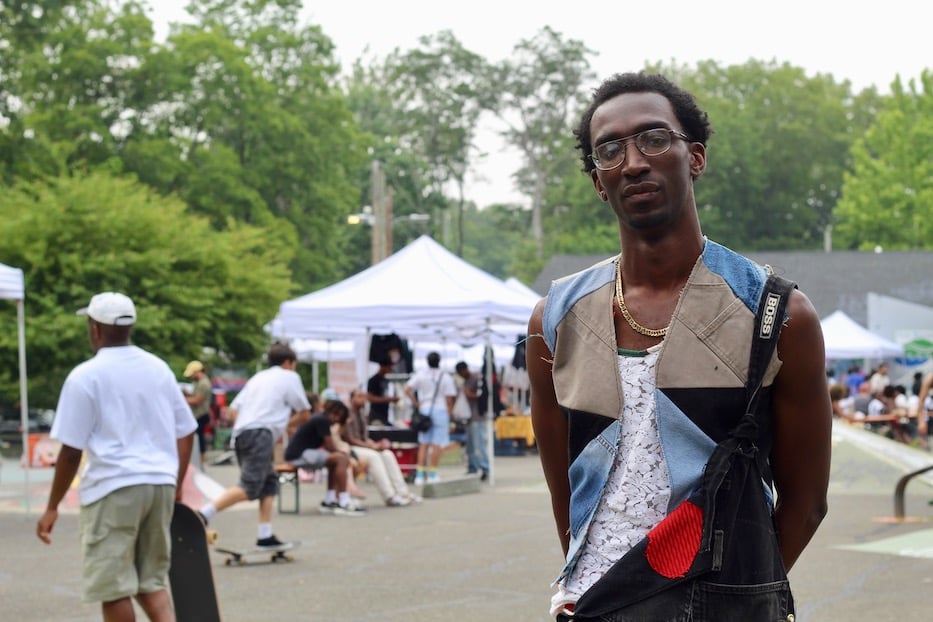
Top: Dawg-o. Bottom: "I'll probably be crying by the end of the day."
"It feels really nice in this moment, letting this space sort of run itself," Moore said as Dawg-O took the stage with a number that he had produced, and the sound became infectious. "I'm a spiritual person, and I fully believe that this vision was God-given. I'm really grateful. I'll probably be crying by the end of the day."
Part of that, he said, is making the festival into an annual event that supports artists and creatives in New Haven. Last year, Moore was debating a move to L.A., and decided to stay to support the creative community. During that time, he built Seeing Sounds because he didn't see anything else like it in the state, and believed that New Haven deserved a large-scale indie music festival. The Waterbury-based rink Roller Magic, where Moore skates, supported the event. Long Wharf Theatre and Black Haven also joined as early partners.
As he grew its footprint this year, Moore envisioned more of everything— more music, more food vendors, more artists and entrepreneurs, more reasons for the community to come together. From one stage, he grew Seeing Sounds to two, with a second nestled in the grass of Edgewood Park and surrounded by artist's tents and picnic benches.
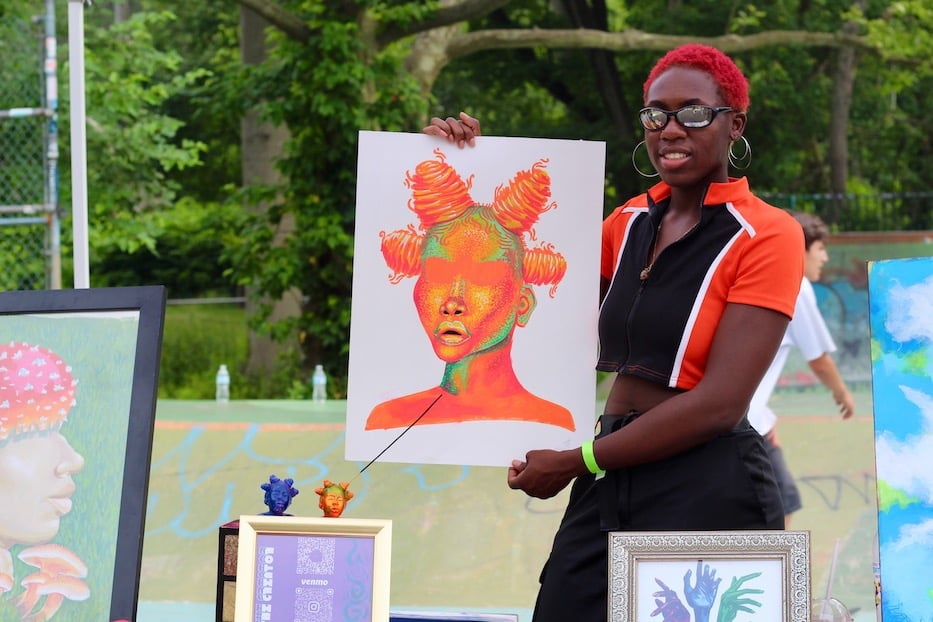
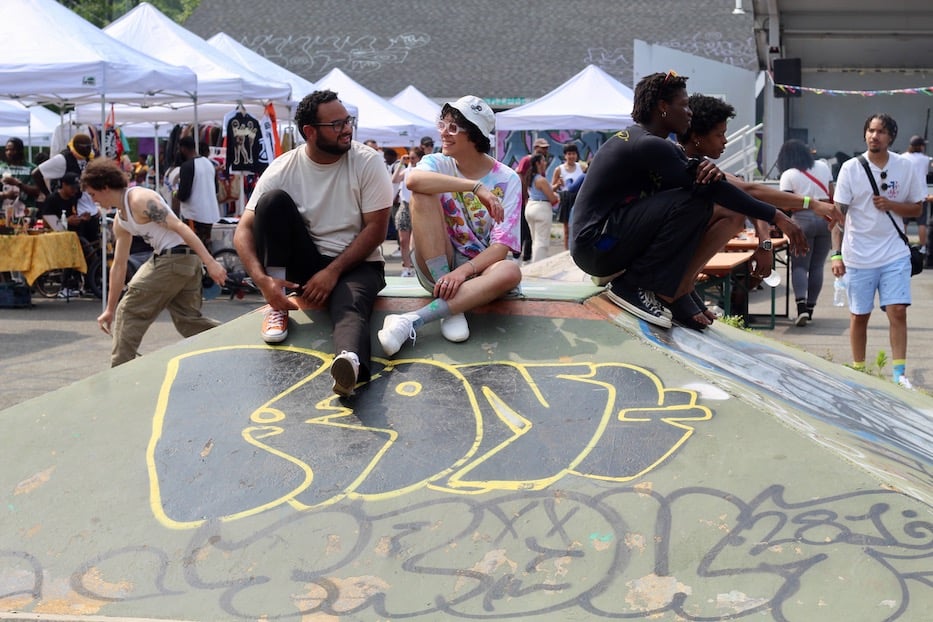
Top: Artist Ashley Innocent, who is based in Hartford.
He also found support from new sources, including the Westville Village Renaissance Alliance, the Community Foundation for Greater New Haven and the city's Department of Arts, Culture & Tourism. Earlier this year, the festival was a recipient of the city's Neighborhood Cultural Vitality Grant, which has allowed it to grow in ways Moore was dreaming of a year ago. When he started, he said, he didn’t know if or when the funding would come. He just trusted the process.
“I’m grounded here,” he said, adding that he sees the festival as a testament to his relationship with a higher power. “I’m settled into the space, enjoying this moment.”
And for hours, it seemed that every artist there was too. As Nehway and Dawg-O welcomed in the afternoon from the main stage, artists celebrated the festival’s second year with dozens of vibrant canvases, pop-up shops, zine stations, a craft beer garden and beadwork that glistened in the sunlight. Close to a row of food trucks that hummed through the afternoon, artist-podcasters Stephen Jackson and Vijor McCray welcomed passers-by into their tent, where two blow-up chairs sat among several potted plants, as if they had been waiting for the day.
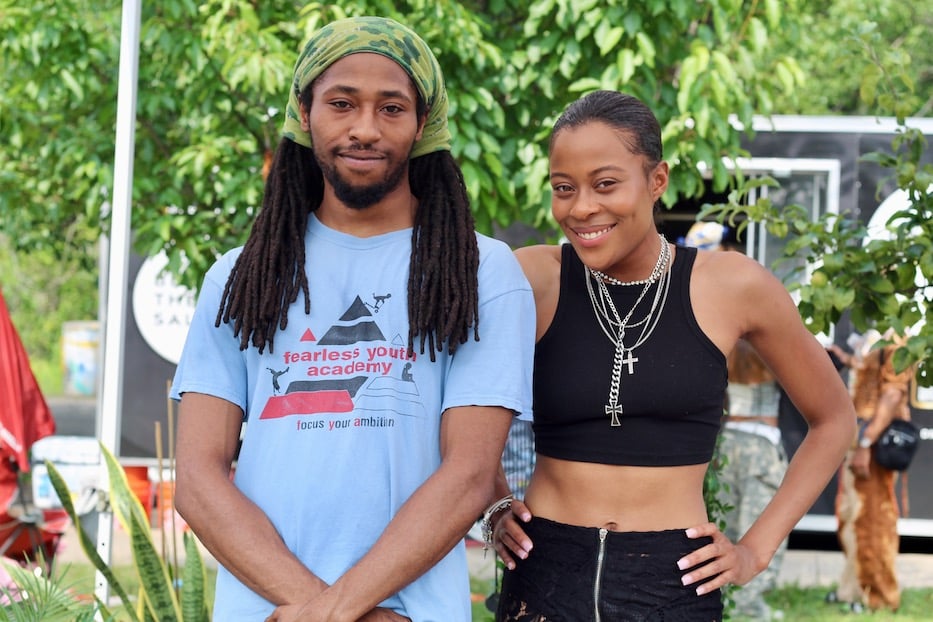
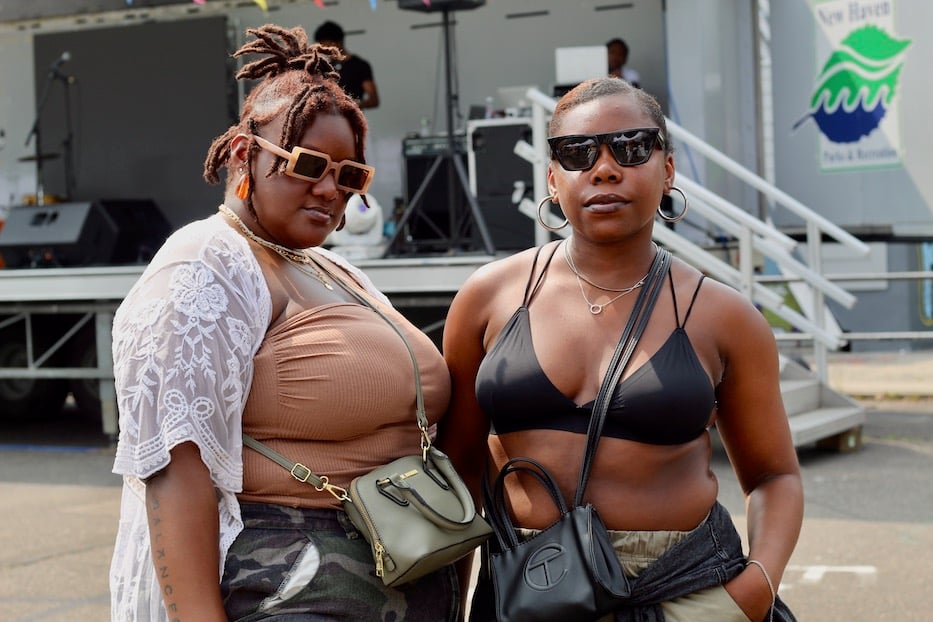
Top: Collective NHV members Stephen Jackson and Vijor McCray. Bottom: Bri Harrington and Kendall Driffin.
As the media agency Collective NHV, the two (their third, Kasaad Bullock, was at Seeing Sounds but elsewhere during the interview) run a series dedicated to conversations among artists—and realized that the festival would be a perfect place to bring that work. Both pointed to the importance of grassroots, do-it-yourself spaces in building meaningful connection among artists, particularly those who have long been relegated to the margins.
“It’s able to bridge a gap,” said McCray, who attended last year and returned as a participant. “It’s great.”
As they made their way toward the stage, first-time attendees Bri Harrington and Kendall Driffin also both applauded the festival as both giving artists a safe and supportive space to perform, and cultivating a sense of community in real time. For Driffin, who is both an actor and teaching artist, it felt simultaneously welcoming and personal and expansive. An hour in, she had already listened to multiple musicians and perused the tents, from bracelets and CBD products to craft beer.
"It's so low-key and intimate, but there's also a sense of community, she said. Particularly as new developments go up downtown and across the city, "this shows people that this is our town and we deserve to be here."
"It gives everybody a chance to be so much more creative or different or weird," Harrington added with a smile that glowed beneath the sun.
For some artists, it also marked a full-circle moment. During the final song of her set, Nehway remembered walking into Seeing Sounds last year as an attendee, and thinking instantly about how much she wanted to be up on the main stage. Born and raised in Waterbury, she has been writing since high school and producing since 2020—but only started coming into her own on the New Haven scene last year.
"Last year, I was out here with my friends, [and] I was like, 'I kind of want to do that,'" she said as an audience cheered her on. "And now we're out here doing it! That should serve as a mantra. I always feel weird telling people things and whatever, but honestly, if you want it, you can have it, you know? You can do it. It's gonna take some time, it's gonna take some tears ... but I promise you, it is so worth it."
Nehway wasn't alone in that sense—several artists praised Seeing Sounds for giving them a place to be themselves, some noting that it also felt like a homecoming. As they prepared for their performance, Indigauxthefae (a.k.a. multi-hyphenate artist Dyme Ellis) remembered coming to Edgewood as a kid, just "floating around like a fairy" around the park as they took in the graffiti, the skaters doing tricks, the hip-hop floating from different stereos in the parking lot.
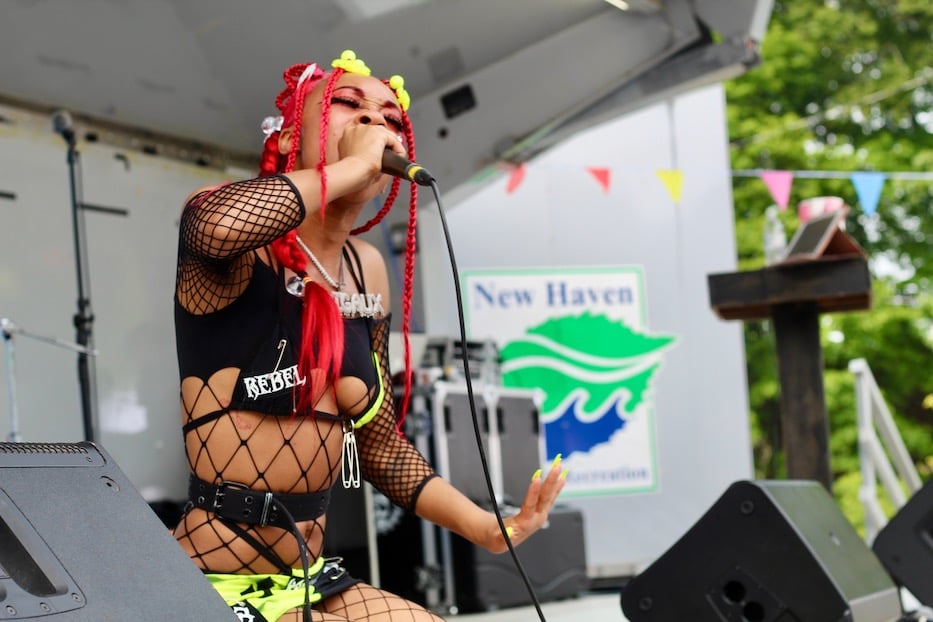
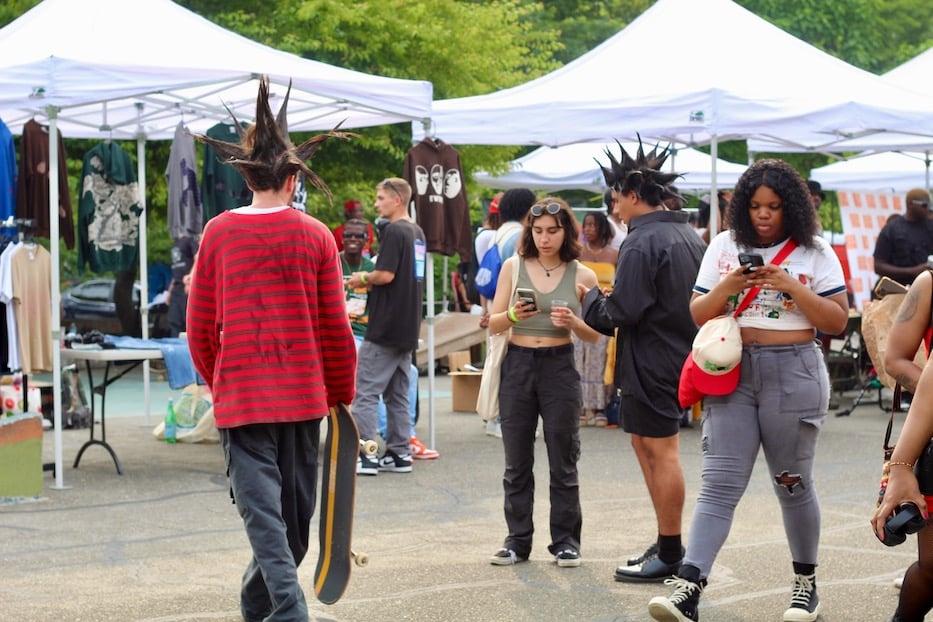
Top: Indigauxthefae during their performance around 4 p.m.
At 12, they started doing poetry and spoken word, picking up skating six years later, and songwriting and performance somewhere along the way. In every stage of their artistic development—particularly as they began performing in New Haven in 2018—Edgewood Park has been a constant. Last year, they were among hundreds of attendees looking up at the stage, and wondering if maybe they had a place there.
"It feels really good," they said, adding that Seeing Sounds, like Punq Noire and Universal Dissent, fills a gap, especially as the city's arts scene moves through a period of seismic transition (read more about that here, here, here and here). "It just felt like, I belong on that stage ... it feels validating."
As a growing audience jammed in front of the main stage, the second "Voyager Stage" became a sanctuary space, complete with listeners who settled in with towels, blankets and food for hours on end. With the rhythmic stylings of Esmer floating over the grass, artists Imani Brown and Cassie Infante took an impromptu dance break, moving slowly among their work.
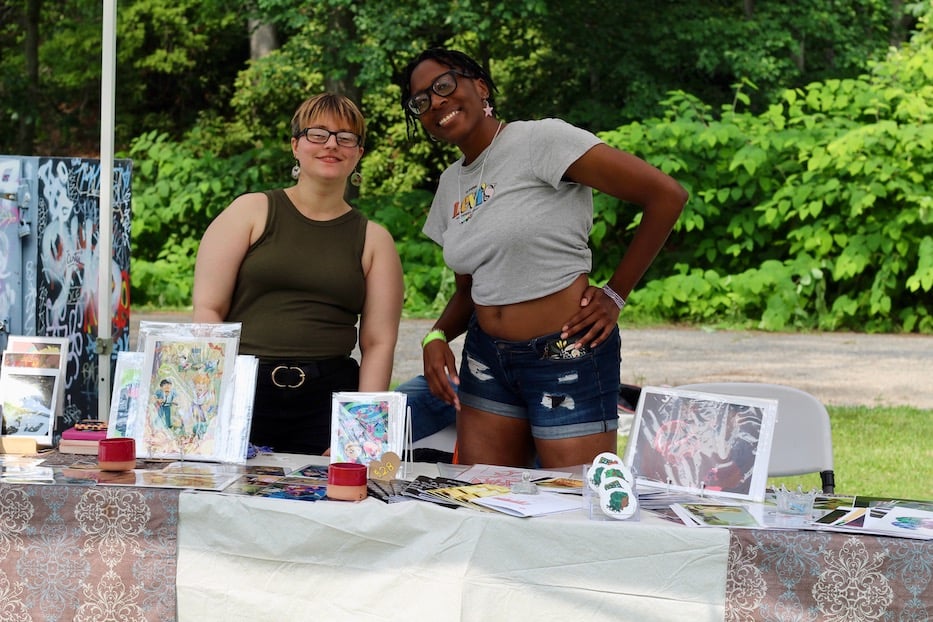
Cassie Infante and Imani Brown.
After watching the festival's birth with their sibling, the artist Amira Brown, last year, Brown said they were excited to see its growth in year two.
"It feels great!" they said. In front of them, artworks filled the table with vibrant color. "I love seeing artists, vendors and musicians all out here ... I am so proud seeing how much it has expanded."
Infante, whose work is inspired by anime and cartoons, added that she was excited to be taking in the festival for the first time. In particular, she said, she loved how queer and DIY it felt, she said. As if on cue, Esmer struck up a final number from the Voyager Stage, and the words wound through the dense, sticky air and out towards the rest of the park.
Sitting on a bright blanket as she painted, the DJ Ch'Varda (a.k.a. painter and crochet artist Jazlyn Council) let herself soak it all in, fitting spoonfuls of cool sorbet in between brushstrokes. Born in New York and raised in Waterbury, Council said she's always loved art, but didn't pick up a paintbrush until Covid-19 forced her into lockdown. While she performed at the festival last year, Saturday marked her first time also vending.
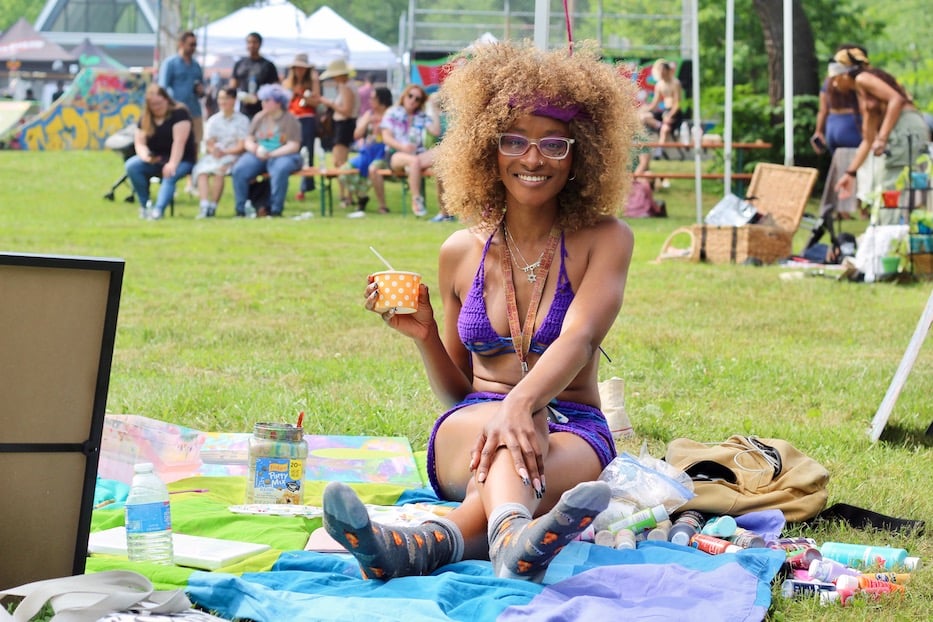
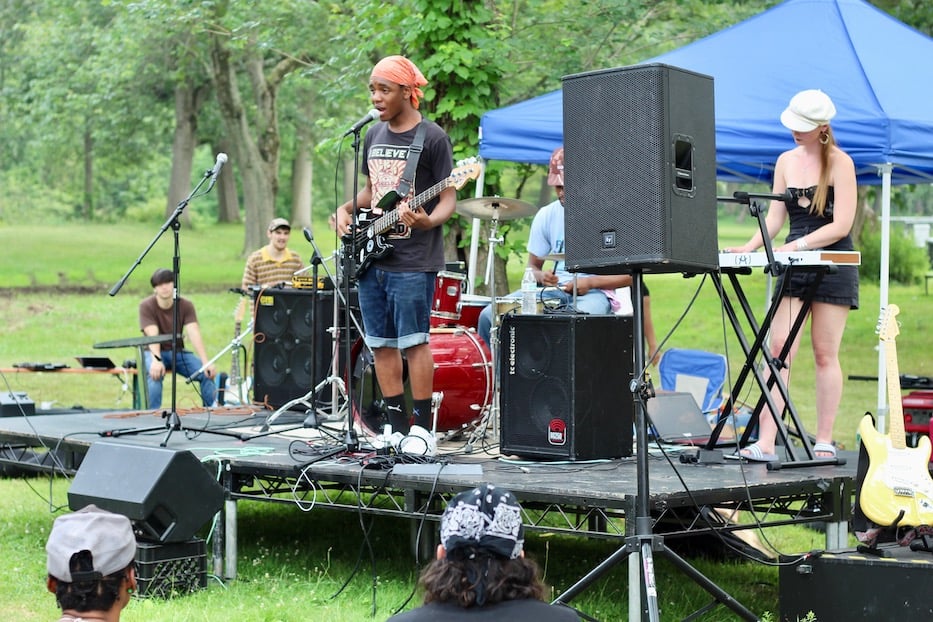
Top: Ch'Varda. Bottom: The Voyager Stage in action.
Because her professional life revolves around mental health—Council has a graduate degree in psychology, and said she's interested in pursuing art therapy—she also looked to Seeing Sounds as a form of healing with other members of the community. Like Driffin, she sees how hard it is for some artists to get a foot in the door in their own city, and also knows that Seeing Sounds is changing that.
"It gives us a bigger stage to showcase what we do," she said. As she chatted, a dainty red crochet bra and pair of bottoms swayed in the breeze above her head. "It gives us a space to be portrayed. Local talent—we can only do so much with what we have. This let us know that the stage is here, [and] this is how we change the community."
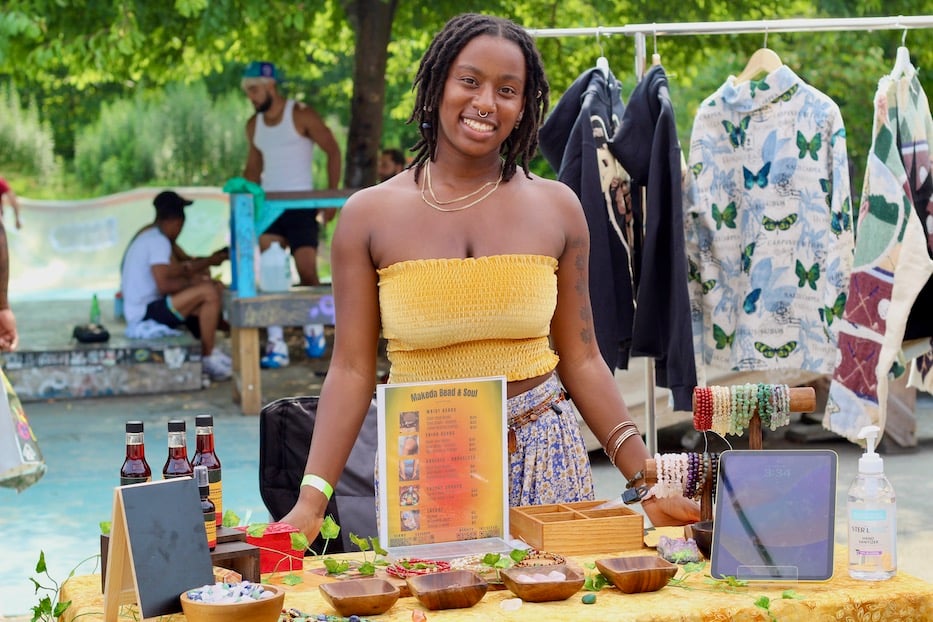
Makeda Snow of Makeda Bead and Soul.
Back near the main stage, maker Makeda Snow said she was excited to be at the festival, now part of her fourth year in business as Makeda Bead & Soul. As she threaded a soon-to-be-ankle bracelet with rose quartz, she took in her surroundings, beaming as a new throng of attendees spilled into the park, and joined a knot of punk musicians with their hair gelled so thickly it stood inches on end.
Nearby, skater Steve Roberts downed the last bite of a callaloo patty, took a sip of juice, and surveyed the skating for the afternoon. Within seconds, he was back on his board, sailing across the concrete in a blur. Further back, Hartford-based artist Ashley Innocent showed off a love of vibrant color and paint, from tableaux inspired by nature to incense holders sculpted to look like faces.
"This just makes me really happy, to be a part of community like this," Snow said. "I think it's important for everybody to be able to have a safe space to express themselves."
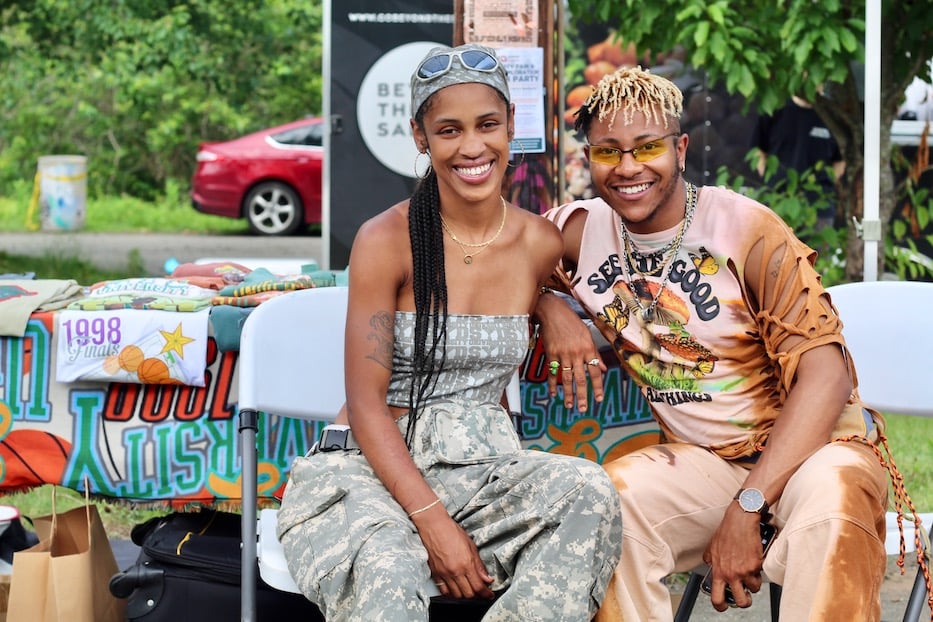
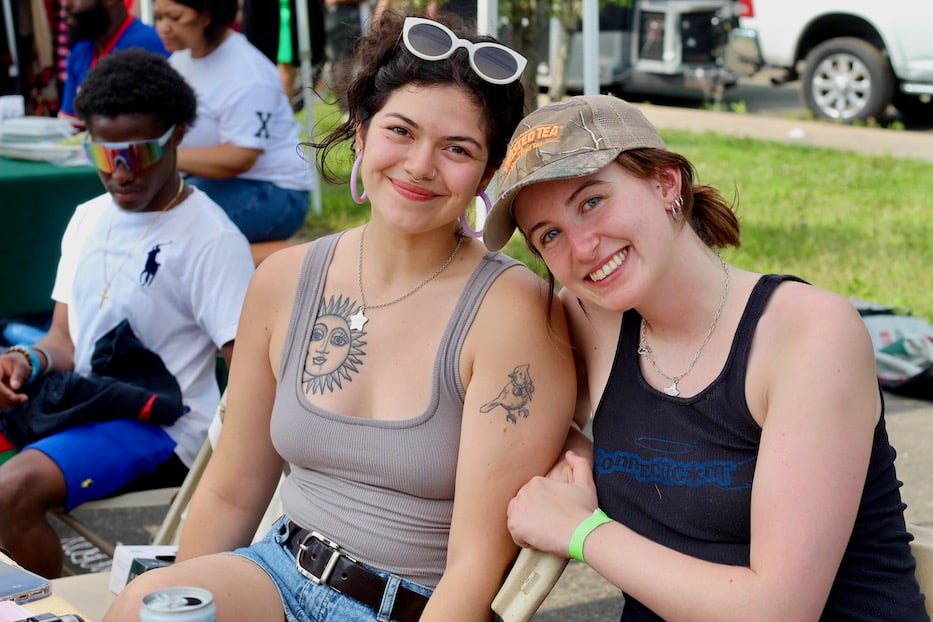
Top: Designers Syd Bell and Cecil Estes III, of Syd University and Gentrii respectively. Bottom: Mar Pelaez and Zoe Jensen of Connectic*nt. The zine turns two this year.
Her words seemed to echo across the expanse of concrete, from fashion-forward tents from Dead By 5 AM, Lower Forms and Syd University to zines makers still coming into their own. As the team from Connectic*nt Mag spoke to attendees about their work, they listened to a symphony of nollies, kickturns, and heelflips on live repeat beneath the music, as if they were an unexpected backing track beneath the music.
On stage, Indigaux pulled the audience close, listeners hanging on to every word. I just ate you up! they exclaimed, and their listeners started to repeat the words, a sweaty mantra for the late afternoon. Channeling their namesake, they floated to the lip of the stage, crouching until one hand was dangling into the crowd, and the other was still cutting the air above the mic.
Moments later, they were a live wire, moving from one end of the stage to the other as they rapped, bounced, and ultimately came down into the crowd without missing a beat.
Halfway across the skate park, Jamal Robinson and Julian Garcia introduced attendees to the Change In The Air Festival, an outlet dedicated to teaching Black people about craft beer and the craft brewing industry. Currently, Robinson said, craft beer is an $80 million industry—of which Black brewers, investors, and owners make up less than one percent.
"People of color, Black folks specifically, have never been marketed to," Garcia said. The festival, held each October at Bear’s Smokehouse, seeks to change that. When Robinson, director of sales and marketing at New England Brewing Company, heard about Moore's vision, it clicked with the work he's trying to do to change the beer industry.
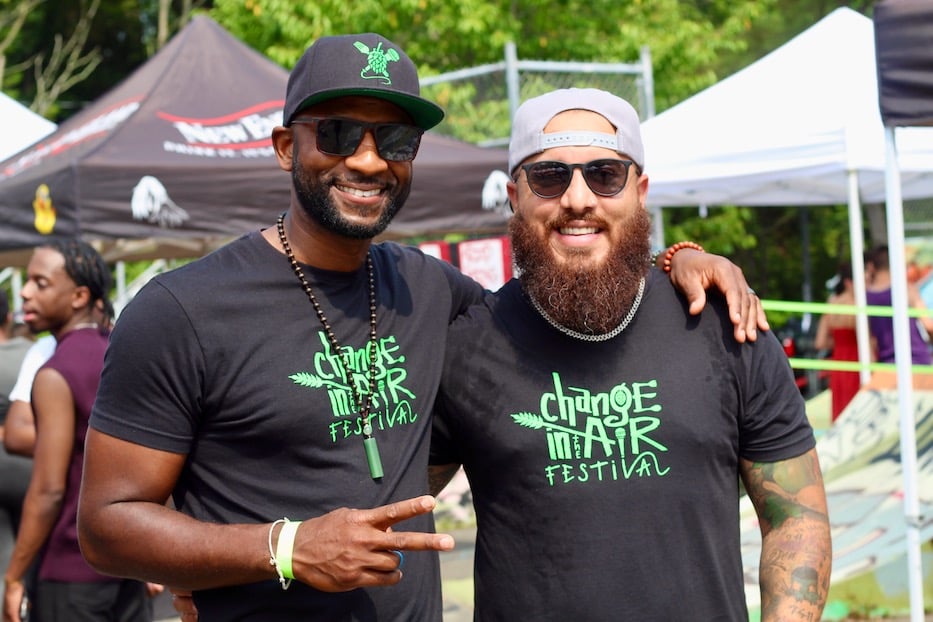
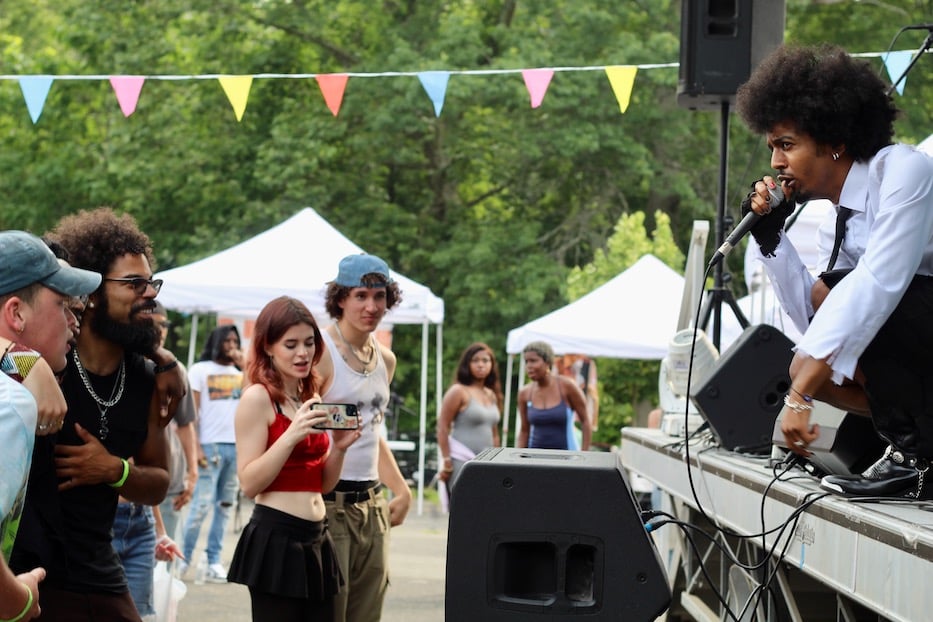
Top: Jamal Robinson and Julian Garcia. Bottom: Ammar.
Back onstage, Ammar introduced a new work that is dropping this month, the lyrics soaring over the crowd. When they finished, their brows furrowed for a moment. This was Seeing Sounds, but not yet quite as they’d imagined. They took a breath, and the afternoon flew forward.
"I need y'all to get closer, like what are we doing here?" they asked, and the audience moved through the thick heat until their heads were at the stage. "Yeah! Come on. Let's make out. That's how close we need to be."
"All right. Listen. Also," they said in a matter-of-fact voice that encapsulated the day. "If you're here for the music, come to the front. If you're here to just vibe and chill, please go to the back."
To learn more about Seeing Sounds, click here. To watch an interview with festival Founder Trey Moore on WNHH Community Radio, click here.

